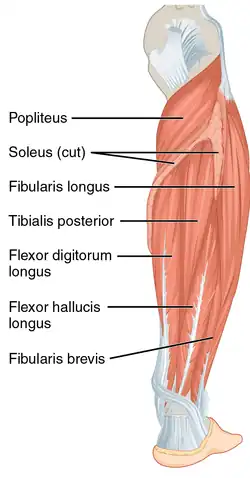Flexor digitorum longus muscle
| Flexor digitorum longus muscle | |
|---|---|
 | |
 View from below | |
| Details | |
| Origin | Posterior surface of the body of the tibia |
| Insertion | Plantar surface; base of the distal phalanges of the four lesser toes |
| Artery | posterior tibial artery |
| Nerve | Tibial nerve |
| Actions | Flexion of the four smaller digits |
| Antagonist | Extensor digitorum longus, Extensor digitorum brevis |
| Identifiers | |
| Latin | Musculus flexor digitorum longus |
| TA98 | A04.7.02.052 |
| TA2 | 2667 |
| FMA | 51071 |
| Anatomical terms of muscle | |
The flexor digitorum longus muscle is situated on the tibial side of the leg. At its origin it is thin and pointed, but it gradually increases in size as it descends. It serves to flex the second, third, fourth, and fifth toes.
Structure

The flexor digitorum longus muscle arises from the posterior surface of the body of the tibia, from immediately below the soleal line to within 7 or 8 cm of its lower extremity, medial to the tibial origin of the tibialis posterior muscle. It also arises from the fascia covering the tibialis posterior muscle.
The fibers end in a tendon, which runs nearly the whole length of the posterior surface of the muscle. This tendon passes behind the medial malleolus, in a groove, common to it and the tibialis posterior, but separated from the latter by a fibrous septum, each tendon being contained in a special compartment lined by a separate mucous sheath. The tendon of the tibialis posterior and the tendon of the flexor digitorum longus cross each other, in a spot above the medial malleolus, the crural tendinous chiasm.[1][2][3] It passes through the tarsal tunnel.[4]
It passes obliquely forward and lateralward, superficial to the deltoid ligament of the ankle-joint, into the sole of the foot, where it crosses over the tendon of the flexor hallucis longus at the level of the navicular bone at a location known as the knot of henry[5] (also referred to as plantar tendinous chiasm),[1][2][3] and receives from it a strong tendinous slip.
It then expands and is joined by the quadratus plantæ muscle, and finally divides into four tendons, which are inserted into the bases of the last phalanges of the second, third, fourth, and fifth toes, each tendon passing through an opening in the corresponding tendon of the flexor digitorum brevis muscle opposite the base of the first interphalangeal joint.
Variation
Flexor accessorius longus digitorum, not infrequent, origin from fibula, or tibia, or the deep fascia and ending in a tendon which, after passing beneath the laciniate ligament, joins the tendon of the long flexor or the quadratus plantæ.
Function
Similar to the flexor hallucis longus and tibialis posterior muscles, the flexor digitorum longus muscle functions to plantar flex and invert the foot. The flexor digitorum longus muscle is responsible for the movement and curling of the second, third, fourth and fifth toes. This muscle makes it possible for the toes to grip the surface of floors, which is important when it comes to maintaining postural balance on surfaces that are rough or uneven. The other deep muscles are the flexor hallucis longus and tibialis posterior; the tibialis posterior is the most powerful of these deep muscles. All three muscles are innervated by the tibial nerve which comprises half of the sciatic nerve.
Clinical significance
After passing through the tarsal tunnel, the flexor digitorum longus tendon must curve around a bony landmark called the sustenaculum tali. Flexor digitorum longus pain can occur with a trip and fall on uneven surface when the toes are not able to grip the surface totally. One can also injure the flexor digitorum longus muscle while running on a beach in the sand without any footwear, making the muscle vulnerable at the calcaneus attachment for injuries. In case of flexor digitorum longus pain or strain, the patient will find it tough to walk and will have excruciating pain in the feet and ankles. Support braces along with warm compresses are the most preferred way of treating flexor digitorum longus pain or strain.
References
![]() This article incorporates text in the public domain from page 485 of the 20th edition of Gray's Anatomy (1918)
This article incorporates text in the public domain from page 485 of the 20th edition of Gray's Anatomy (1918)
- 1 2 Walter Thiel (1997) Photographic atlas of practical anatomy - Volume 1, Part 1 - p.348
- 1 2 Johannes Sobotta, Reinhard Putz, Reinhard Pabst (1997) Sobotta Atlas of Human Anatomy: Thorax, abdomen, pelvis, lower limb, p.331
- 1 2 Jan Langman, Martinus Willem Woerdeman (1982) Atlas of medical anatomy p.323
- ↑ Gujar, Bansari; Flores, Raymond H. (2015-01-01), Hochberg, Marc C.; Silman, Alan J.; Smolen, Josef S.; Weinblatt, Michael E. (eds.), "81 - Entrapment neuropathies and compartment syndromes", Rheumatology (Sixth Edition), Philadelphia: Mosby, pp. 671–682, doi:10.1016/b978-0-323-09138-1.00081-4, ISBN 978-0-323-09138-1, retrieved 2021-02-21
- ↑ Knipe, Henry. "Knot of Henry | Radiology Reference Article | Radiopaedia.org". Radiopaedia. Retrieved 20 October 2020.
External links
| Wikimedia Commons has media related to Flexor digitorum longus muscles. |
- Anatomy photo:15:st-0403 at the SUNY Downstate Medical Center
- PTCentral